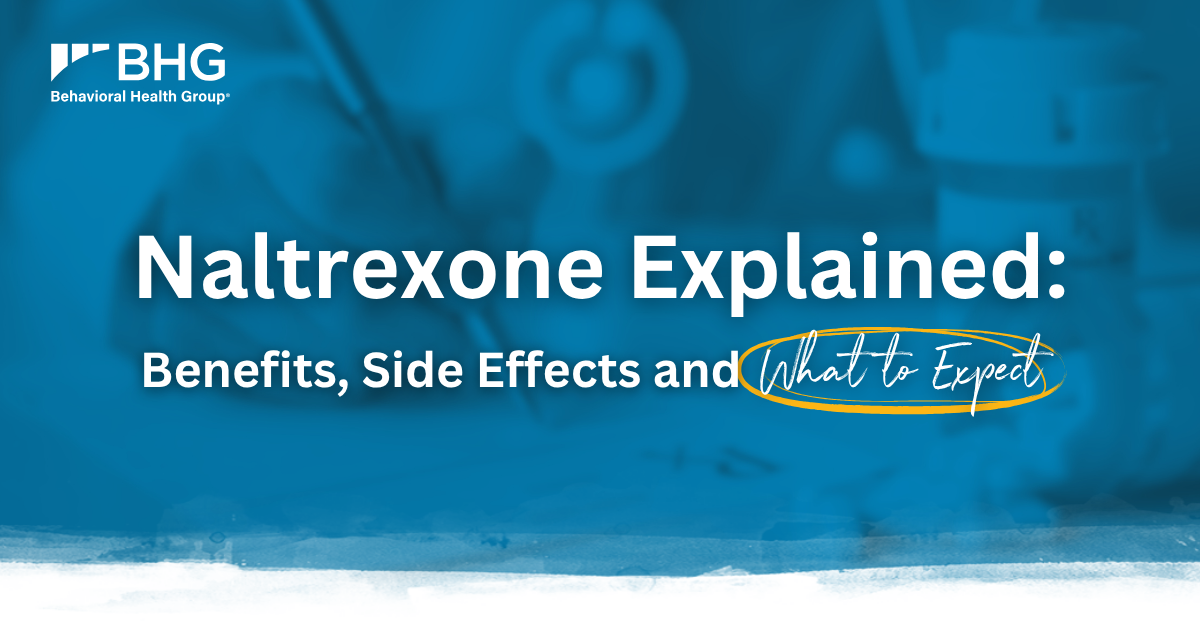
When it comes to treating opioid and alcohol use disorders, one FDA-approved medication offers a unique path to recovery: naltrexone. Unlike medications that contain opioids, naltrexone stands out as an option, offering a distinct approach to treatment by helping to reduce cravings and prevent relapse without the risk of dependence or misuse.
But what exactly is naltrexone? How does it work? And is it right for your recovery journey? Here’s everything you need to know about this medication.
What Is Naltrexone?
Naltrexone is an opioid antagonist, meaning it blocks the effects of opioids in the brain. As an opioid antagonist, it helps reduce cravings and prevents opioids from producing their usual ‘high.’ One of the key advantages of naltrexone is that it’s not a controlled substance, and there are no withdrawal symptoms if you stop taking it. It’s part of a broader, evidence-based approach called medication-assisted treatment (MAT), which combines medication with counseling and wraparound services.

Naltrexone comes in two main forms:
- Extended-release injection (brand name Vivitrol): Administered once a month by a healthcare provider. This form is administered at Behavioral Health Group (BHG) for individuals receiving treatment for opioid use disorder (OUD).
- Oral tablet: Typically prescribed for alcohol use disorder (AUD). Due to the increased risk of overdose if doses are missed, BHG does not offer the oral formulation for OUD.
At BHG, we prioritize safety and long-term success in recovery. That’s why we use the extended-release injection for OUD treatment - ensuring consistent medication coverage and reducing the risk of relapse or overdose.
How Naltrexone Works
Naltrexone works by targeting the brain's reward system - specifically, the opioid receptors. Whether it’s opioid or alcohol, these substances work to activate cells in the brain that release feel-good chemicals like dopamine. Naltrexone blocks those receptors, preventing opioids from producing their euphoric effects. This helps reduce cravings and prevents relapse by stopping the cycle of reward-seeking behavior.
Think of Naltrexone as a shield. Even if you feel tempted to use opioid or alcohol, the medication stops the substance from having its usual rewarding effect on your brain. Over time, this helps break the cycle of reward-seeking behavior that drives addiction and supports long-term recovery.

Before starting Naltrexone, you’ll need to be free from opioids for 7–10 days. Taking the medication too soon may lead to withdrawal symptoms. Your healthcare provider will guide you through a safe and supported process before beginning treatment.
Potential Side Effects of Naltrexone: What You Need to Know
Like most medications, Naltrexone can cause side effects. The good news is that most are mild and temporary, especially as your body adjusts. Still, it's important to be aware of both common and more serious side effects, and when to contact your healthcare provider.
Common Side Effects
- Headache
- Nausea or vomiting
- Cold-like symptoms
- Decreased appetite
- Dizziness or drowsiness
Serious Side Effects
- Severe reactions at the injection site (redness, swelling, pain)
- Liver damage (especially with high doses or in individuals with liver conditions)
- Pneumonia
- Mood changes, including depression or thoughts of self-harm
If you experience any symptoms that feel unusual or concerning, contact your healthcare provider right away. It’s always better to check in early and stay ahead of any potential complications. For urgent or severe reactions - like difficulty breathing or signs of a severe allergic reaction, call 911 immediately.

Who Should Avoid Naltrexone
While naltrexone is safe for many people, it’s not the ideal medication for everyone. You should avoid naltrexone if:
- You have not been completely opioid free for at least 7-10 days
- You have severe liver disease or abnormal liver function
Everyone’s recovery journey is unique and Naltrexone can affect people differently based on individual health and medical history. That’s why it’s important to work closely with your provider to monitor your progress and adjust treatment as needed. Most importantly, working with your provider can ensure this medication is a safe and effective fit for you.
Benefits of Naltrexone
Naltrexone offers a range of powerful benefits that can support you throughout your recovery. It’s designed to help individuals stay focused, reduce cravings and reduce the risk of relapse. Here's how it can make a difference in your recovery process:
- No risk of physical dependence: Naltrexone does not cause withdrawal symptoms if stopped and is not associated with misuse or addiction.
- Reduces cravings: It helps minimize the urge to use by interrupting the brain’s reward response.
- Blocks opioid effects: By blocking the effects of opioids (and alcohol in other cases), it removes the ‘high’ that fuels substance use, lowering the risk of relapse.
- Convenient options: Naltrexone is available as a once-monthly injection (used at BHG for OUD) and a once-daily oral pill (typically prescribed for AUD).
- Clinically proven: Naltrexone is backed by research showing significant improvements in recovery outcomes.

Explore Naltrexone Treatment for Opioid Use Disorder at BHG
Recovery is a path worth taking and you don’t have to walk it alone. At BHG, we provide support for opioid use disorder (OUD) all in one place—offering Naltrexone treatment as part of our comprehensive, evidence-based care model, coupled with counseling, case management and other wraparound services. As one of only 4% of programs nationwide offering all FDA-approved medications, we give you the flexibility to find the approach that works best for you, so you can move forward with confidence.
If you or a loved one is ready to start recovery or needs help now, give us a call at 844-535-7291 or find a BHG location near you.
If you’re a healthcare provider or a referring partner, please call our dedicated referral line at 866-763-2244 or submit an online referral form on our website. We’re here to help guide you every step of the way.
Frequently Asked Questions
No. Your body must be opioid-free for 7-10 days before starting naltrexone. If there are still opioids in your system, taking naltrexone can cause sudden and intense withdrawal symptoms. That’s because the medication blocks opioid receptors but doesn’t activate them - so it won’t help with withdrawal. It’s designed to be used after you’re clear of opioids in your system and are past the withdrawal phase of recovery.
The length of naltrexone treatment depends on your individual needs and recovery goals. Some people take it for a few months to stabilize, while others may continue longer for ongoing relapse prevention. Meeting with your healthcare provider will help you decide what’s best for your recovery plan.
In many cases, yes. Naltrexone can be used safely with non-opioid medications, including those for mental health (like antidepressants) or general health conditions. However, it should never be combined with opioid-based medications as doing so can lead to serious side effects or block the medication's intended effects. If you have a question about combining Naltrexone and a medication you are currently taking, talk to your provider before starting Naltrexone.
Yes, you can still feel pain while taking naltrexone. Naltrexone blocks the effects of opioids, so opioid painkillers won’t be effective. But non-opioid options like ibuprofen, acetaminophen or other types of pain medications still work. If you’re planning to have surgery or expect to need strong pain relief, talk to your doctor ahead of time to make a safe plan.
If relapse occurs while on naltrexone, the medication will block the euphoric effects of opioids, which may discourage continued use. However, it's important to seek medical help immediately, especially if a person tries to override the block by taking higher doses of opioids, which can be extremely dangerous and increase the risk of overdose. A relapse is not a failure; it's a sign to revisit your recovery plan with your care team and make adjustments as needed.
While Naltrexone can be a highly effective tool in your recovery, it’s important to follow certain guidelines to make sure it works as intended. To get the best results, here are a few things to avoid:
- Opioid use: Don’t use opioids while on Naltrexone. If a person tries to override the block by taking higher doses, it can block the effects of naltrexone and can increase the risk of overdose.
- Drinking alcohol (in some cases): You should avoid alcohol while on Naltrexone, as it may interfere with your treatment. Check with your doctor if you’re unsure.
- Missing doses: Whether you’re taking the daily pill or the monthly injection, sticking to your treatment schedule is key. Skipping doses can make the medication less effective and can increase the chance of a fatal opioid overdose.
- Starting too soon after using opioids: You need to be free from opioids - usually 7–10 days - before starting Naltrexone. Starting too early can trigger withdrawal symptoms.
- Over-the-counter opioid meds: Some over-the-counter cough syrups and painkillers contain opioids. Always check labels and consult with your provider before starting a new medication.
By staying on track and avoiding these common pitfalls, you’ll give yourself the best chance for a successful recovery. Always keep your healthcare provider in the loop to make sure everything goes smoothly.
